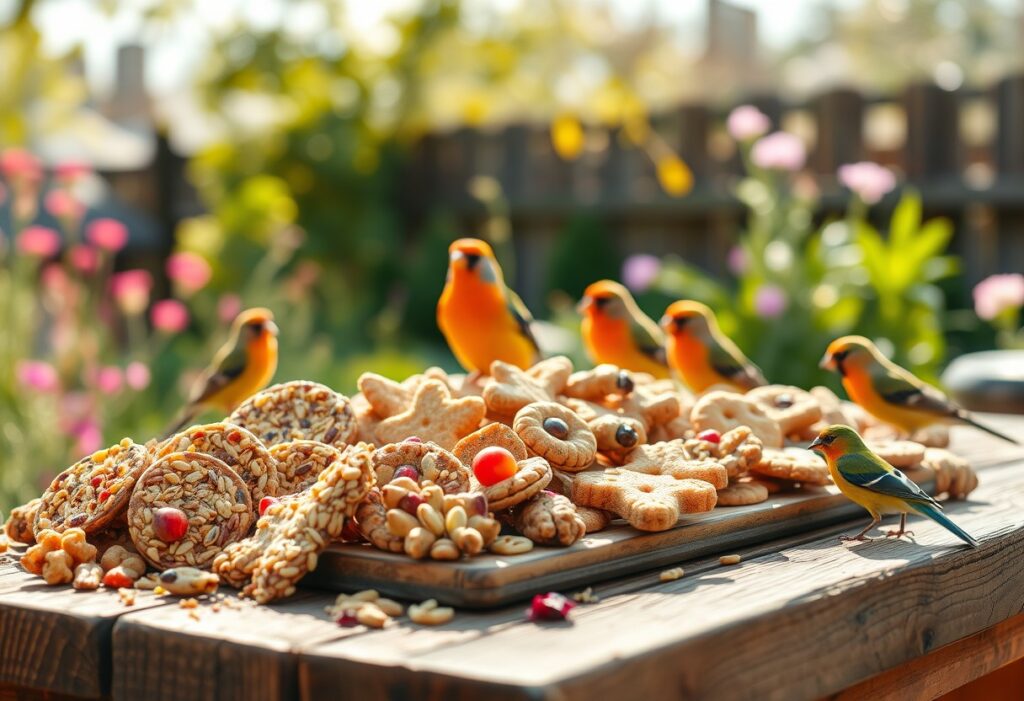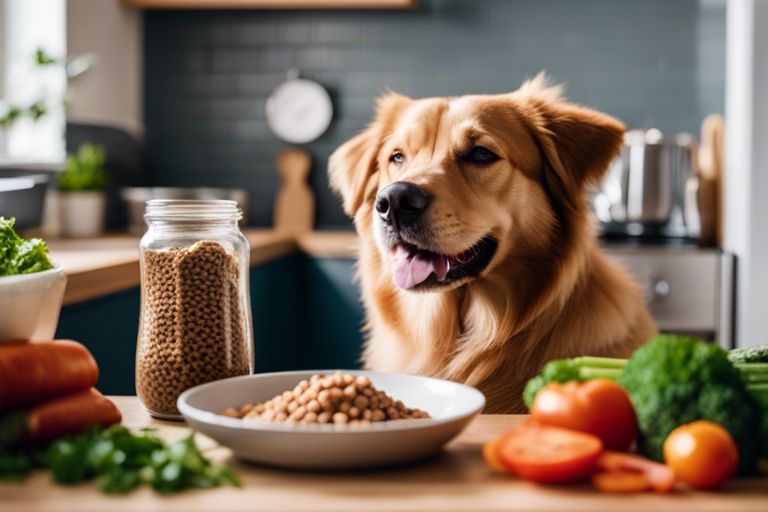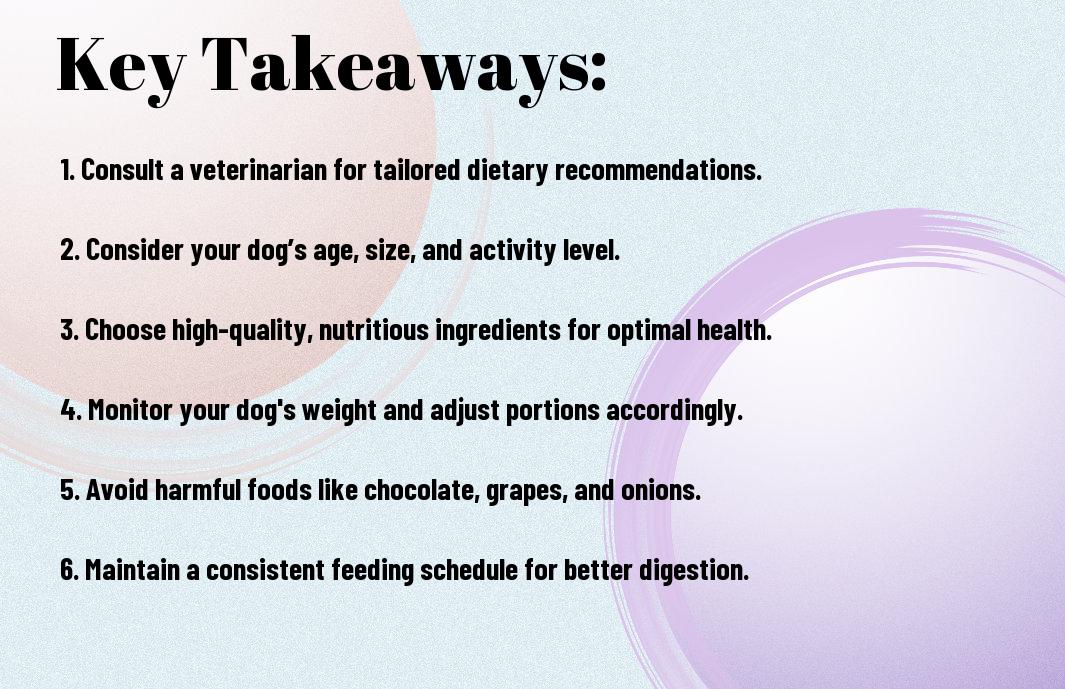Many bird lovers enjoy the rewarding experience of creating healthy and delicious treats for their feathered friends. By making your own homemade bird treats, you can provide nutrient-rich snacks while ensuring they are free from harmful additives. In this guide, you will discover simple recipes and tips to help you create a variety of treats tailored to your birds’ preferences. With just a few ingredients, you can enhance your avian companions’ diet and enrich their lives!
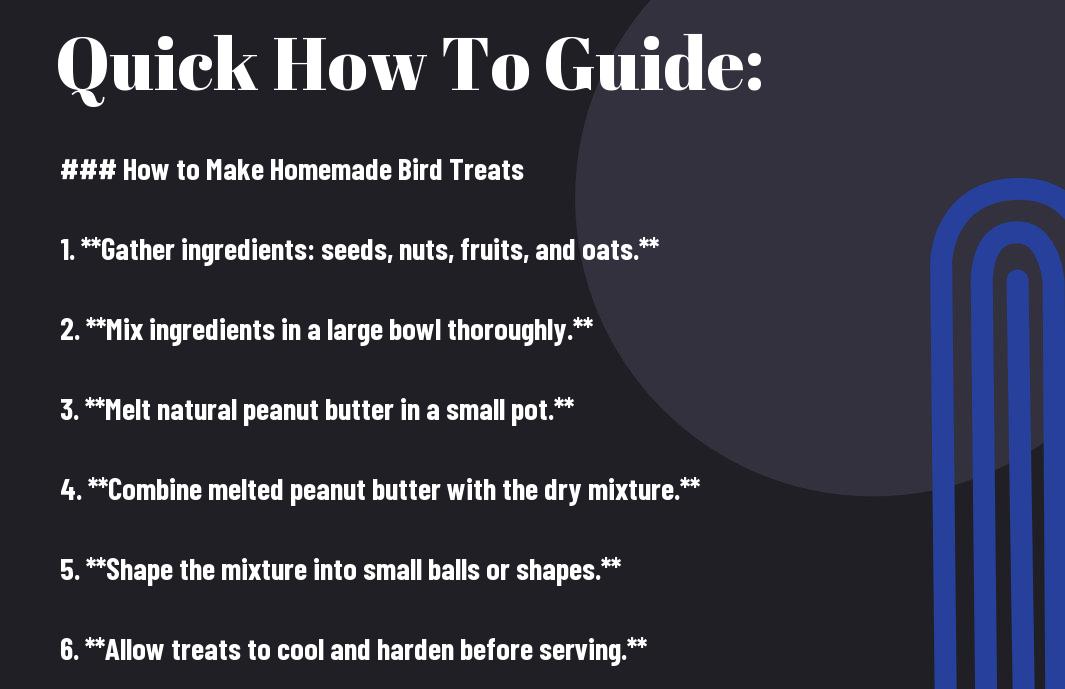
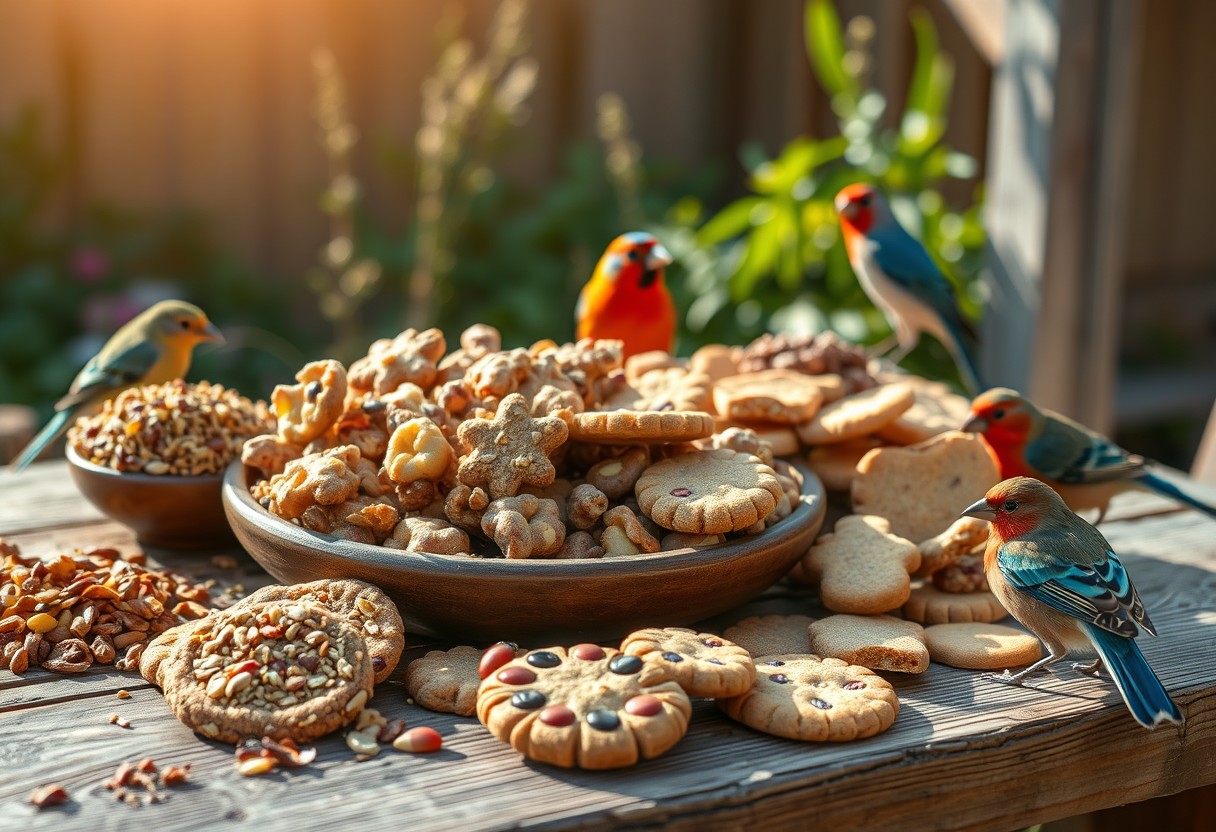
Understanding Bird Nutrition
For those looking to create the best homemade bird treats, understanding the nutritional needs of your avian friends is important. Just as with any other pets, birds require a balanced diet to thrive, and providing them with treats that meet these nutritional needs ensures they remain healthy and active. Nutrition for birds encompasses a mix of proteins, carbohydrates, fats, vitamins, and minerals. You’ll want to familiarize yourself with the important nutrients that form the backbone of their diet to make informed choices about the treats you prepare.
Essential Nutrients for Birds
Birds primarily need a diet rich in proteins, which are crucial for growth and tissue repair. They typically source their protein from seeds, nuts, or insects. In addition, carbohydrates provide the energy needed for daily activities and play a pivotal role in their overall health. Birds also require adequate fats for insulation and energy, especially in colder climates.
Alongside these macronutrients, vitamins and minerals are vital for various bodily functions. Vitamin A contributes to proper eyesight and immune function, while calcium is important for strong bones and egg production in females. Understanding these dietary components will help you create well-rounded treats that boost your bird’s health.
Common Ingredients for Bird Treats
With numerous ingredients available, it’s crucial that you choose those that are safe and nutritious for your birds. Common ingredients in homemade bird treats often include various seeds, nuts, fruits, and vegetables. Each of these ingredients contributes uniquely to your birds’ dietary needs, so knowing how to combine them increases the nutritional value of the treats.
Birds can enjoy a range of seeds such as sunflower seeds or millet and can similarly intake nuts in moderation, providing both texture and flavor to your treats. Incorporating fresh fruits like apples or berries not only adds a dose of sweetness that birds love but also delivers important vitamins. However, remember to avoid harmful foods like avocado and chocolate, as these can pose a serious risk to your birds’ health. Ultimately, the right combination of ingredients can make for delicious and safe homemade bird treats that your feathered friends will relish!
How to Choose Your Ingredients
Assuming you are ready to create some delightful homemade bird treats, the first step involves understanding how to choose your ingredients wisely. This choice can significantly impact the health and happiness of the birds you are catering to. When dicking out ingredients, consider the specific species of birds you want to attract; different birds have different dietary needs. Make sure the ingredients you use are safe and suitable for the types of birds in your area. After all, even the most appealing treats may not be beneficial if they’re not tailored to your feathery friends’ preferences.
Factors to Consider When Selecting Ingredients
To enhance your bird treats, there are crucial factors to weigh when selecting your ingredients. These factors include the nutritional value, availability, and seasonal variations of the ingredients. Look for items rich in proteins, fats, and fiber to ensure a well-rounded treat. Here are some points to keep in mind:
- Freshness: Ensure that the ingredients are fresh to provide maximum nutrition.
- Allergies: Some birds may have sensitivities, so avoid potentially harmful ingredients.
- Variety: Include a range of ingredients for balanced nutrition.
Thou can create exciting combinations that also cater to the different needs of your local avian inhabitants.
Tips for Sourcing Quality Ingredients
While crafting your homemade bird treats, the quality of your ingredients plays a vital role in the final product. Purchasing ingredients from reputable sources ensures that you are feeding your feathered friends the best. Check labels carefully to avoid additives or preservatives, as these can be harmful. Here are some practical tips for sourcing quality ingredients:
- Local farmers: Support them for fresh, organic produce.
- Health food stores: These shops often offer high-quality seeds and nuts.
- Online retailers: They can provide a wide selection of specialty ingredients.
Recognizing the importance of quality will not only enhance the attractiveness of your treats but also ensure that they are healthy and safe.
Your journey towards creating delicious homemade bird treats is about more than just mixing ingredients. It’s also about knowing where to find those ingredients and understanding their benefits. Seek out organic alternatives, and opt for nuts, seeds, and grains that are as close to their natural state as possible. Avoid using processed foods that can include harmful additives. Remember to choose ingredients that are both healthy and appealing to the birds you wish to attract. Consistently using quality and fresh ingredients will lead to better treats and happier birds! Recognizing the impact of your choices will make your bird-feeding experience rewarding.
Step-by-Step Guide to Making Bird Treats
Not all birds have the same dietary needs, but crafting delicious homemade bird treats is an enjoyable way to cater to a variety of feathered friends. In this section, we will outline the steps to create nutritious and fun bird treats right in your kitchen.
Essential Ingredients
| Ingredient | Purpose |
| Seed Mix | Provides energy and important nutrients |
| Nuts | High in protein and fats, great for energy |
| Fruit | Offers vitamins and a natural sweetener |
| Peanut Butter | Acts as a binding agent while being tasty |
| Gelatin (optional) | Helps solidify treats when using soft ingredients |
Basic Recipes for Homemade Bird Treats
For a simple yet effective bird treat, consider making seed cakes. Combine your choice of bird seed mix with peanut butter and some chopped nuts in a bowl. Mix the ingredients well and then press them into cookie cutters, forming cute shapes like hearts or stars. Allow the mixture to set for a few hours in the refrigerator before placing them in your backyard for the birds to enjoy.
Another basic recipe involves using gelatin. Dissolve one packet of unflavored gelatin in water and mix in your seed blend, fruit pieces, and nuts. Pour the mixture into molds and let it set until solid. These homemade treats are an excellent source of nutrition for your birds and can be easily customized to suit their preferences.
Creative Options for Variety
With a variety of ingredients at your disposal, you have numerous options to add flair and excitement to your homemade bird treats. Experiment with different seeds, nuts, and fruits to discover what your visiting birds prefer. Adding dried fruits like raisins or cranberries can provide a sweet twist that many birds can’t resist!
This creative approach extends beyond just the ingredients of your bird treats. Try incorporating different textures—like crunchy nuts and soft fruits—into your recipes. Birds are often attracted to colorful, eye-catching treats, so consider using a mix of red, yellow, and green ingredients to create vibrant snacks. Don’t hesitate to innovate and adapt your recipes based on the birds that frequent your garden, ensuring they receive not only the nutrition they need but also some delightful variety in their diet.
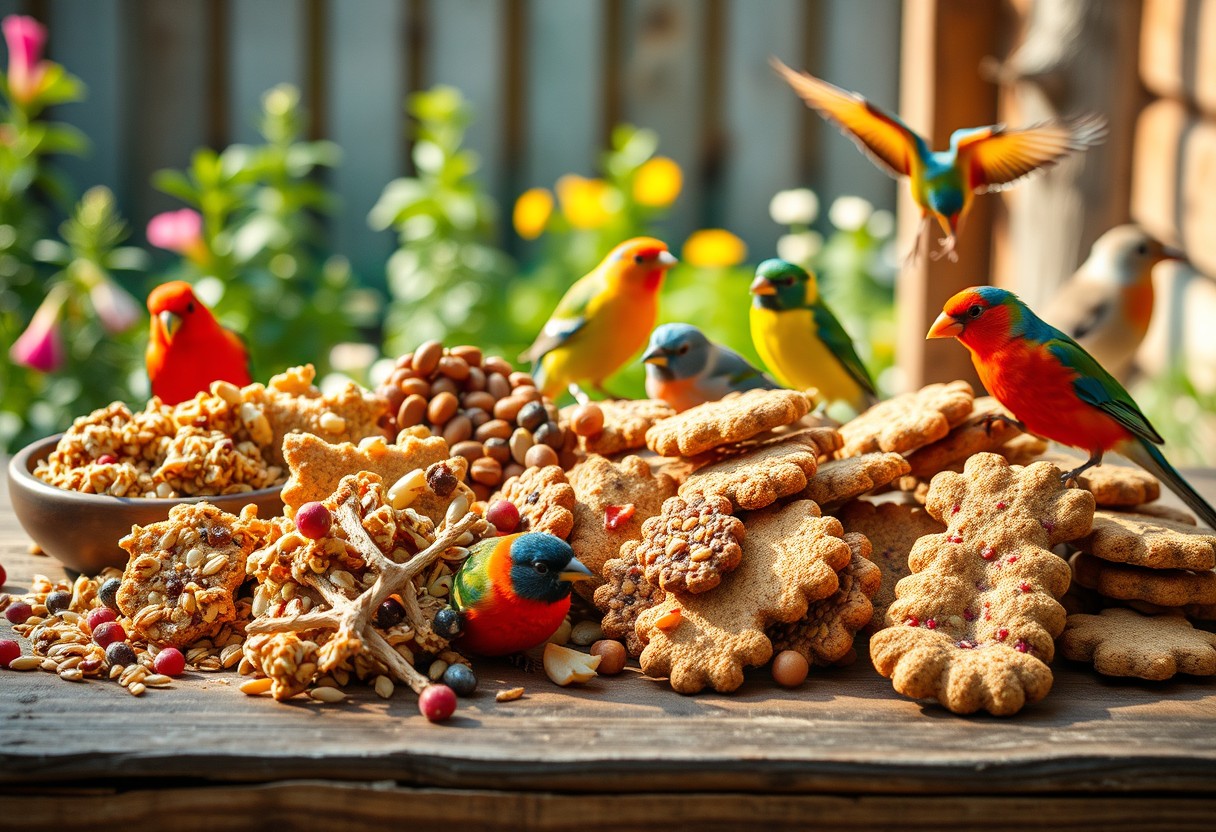
Storing and Serving Bird Treats
Once again, proper handling of homemade bird treats is vital to ensure the safety and enjoyment of your feathered friends. The way you store these treats can significantly affect their freshness and quality. By taking a few simple steps, you can prolong the life of your creations while keeping them appealing to birds. Remember that exposure to air, moisture, and temperature fluctuations can all impact your treats negatively.
Tips for Proper Storage
One vital tip for storing your homemade bird treats is to place them in an airtight container. This prevents moisture from getting in and helps maintain freshness. It’s also advisable to keep your treats in a cool, dry place, such as a pantry or cupboard, away from direct sunlight. Here are a few more recommendations for proper storage:
- Use freezer bags for long-term storage if you make treats in bulk.
- Label your containers with the date of preparation to track their freshness.
- Avoid storing treats near strong-smelling foods as they can absorb unwanted odors.
Assume that by following these guidelines, you can create a safe environment for your homemade bird treats. Regularly check for signs of spoilage and discard any old or stale treats to ensure your birds only receive the best.
How to Serve Bird Treats Effectively
For the best results when serving bird treats, be mindful of the feeding habits and preferences of your birds. Position your treats in bird feeders or hanging treats where they can easily access them, always ensuring that they are clean and free from mold or decay. You want to observe how your birds interact with the treats and be ready to modify how and when you serve them based on their reactions.
Effectively encouraging your birds to enjoy the treats you’ve made involves knowing the right timing and method of serving them. Position the treats during peak feeding times, which typically occurs early in the morning or late in the afternoon. If you introduce new treats, consider mixing them with their regular food to help them acclimate to the new flavors. Always be cautious about creating a *messy* feeding area as this can lead to unsanitary conditions or pest attraction. With these strategies, you can turn mealtime into a delightful experience for your birds, ensuring that they relish every bite!
Summing Up
As a reminder, preparing homemade bird treats is a rewarding and enjoyable way to provide your feathered friends with nutritious snacks while also creating a bonding experience with them. By selecting quality ingredients, you can tailor the treats to meet the specific dietary needs of the birds in your area. Whether you decide to make seed blocks, fruit mixes, or peanut butter-based treats, you can feel confident that your creation will contribute to the health and happiness of the birds visiting your yard.
In addition to knowing how to create these treats, it’s crucial to remember the importance of presentation and freshness. You should always store your homemade bird treats in a cool, dry place, and regularly check for any signs of spoilage before offering them to your avian visitors. By taking the time to create and maintain these nutritious offerings, you not only foster a natural environment for the birds but also enhance your connection with nature, enriching your personal experience as a bird lover.
FAQ
Q: What ingredients can I use to make homemade bird treats?
A: You can use a variety of healthy ingredients to make homemade bird treats! Some popular options include seeds (such as sunflower seeds, millet, and flaxseeds), nuts (like almonds and walnuts), dried fruits (such as raisins and cranberries), fresh fruits (like apple and banana), and vegetables (including carrots and leafy greens). You can also incorporate grains like oats or whole grain bread. Just make sure to avoid processed sugars, salt, and toxic foods like avocado and chocolate, as they can be harmful to birds.
Q: How do I properly store homemade bird treats?
A: Storing homemade bird treats properly is important to maintain their freshness and prevent spoilage. Once your treats are made, allow them to cool completely before storing. Place them in an airtight container to keep them safe from moisture and pests. You can store them at room temperature for a week, but for longer-lasting treats, consider refrigerating them for up to two weeks or freezing them for up to six months. Just be sure to thaw them completely before serving to your birds.
Q: Can I customize homemade bird treats for different types of birds?
A: Absolutely! Different birds have varying dietary needs and preferences, so you can easily customize your homemade treats. For example, larger birds like parrots enjoy nuts, fruits, and veggies, while smaller birds like finches may prefer seeds and grains. Research the specific dietary needs of the bird species you are catering to, and adjust the ingredients accordingly. You can also consider incorporating spices or herbs that are safe for birds, such as cinnamon or parsley, to add variety and flavor to their treats!
